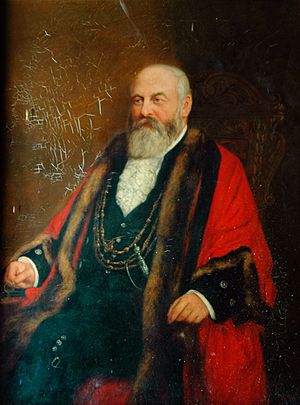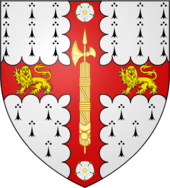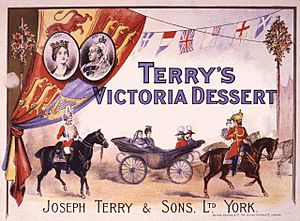Joseph Terry facts for kids
Quick facts for kids
Sir Joseph Terry
|
|
|---|---|

Lord Mayoral portrait by George Fall, 1897
|
|
| Lord Mayor of York | |
| In office 1874–1875 |
|
| Preceded by | John March |
| Succeeded by | Edward Rooke |
| In office 1885–1887 |
|
| Preceded by | John Close |
| Succeeded by | Joseph Sykes Rymer |
| In office 1890–1891 |
|
| Preceded by | Philip Matthews |
| Succeeded by | John Close |
| Personal details | |
| Born | 7 January 1828 York, England |
| Died | 12 January 1898 (aged 70) Royal Station Hotel, York, England |
| Political party | Conservative |
Sir Joseph Terry (born January 7, 1828 – died January 12, 1898) was an important British businessman and politician. He was a confectioner, meaning he made sweets and chocolates. He was also an industrialist, which means he ran large factories. Joseph Terry was a member of the Conservative Party. He served as the Lord Mayor of York three times.
Before becoming Lord Mayor, he was a deputy mayor. He held this role as the town's sheriff in 1870. From 1860, he was a Councillor for York's Monk Ward. A councillor helps make decisions for the local area. He also worked as a Justice of the Peace (JP). This meant he helped keep law and order in York and North Yorkshire from 1887 until he passed away.
Sir Joseph Terry is famous for making the confectionery company Terry's a huge success. His father had started the company. Joseph helped it grow by using the Humber Estuary to bring in important ingredients. These included sugar and cocoa. Later, he made the company focus mainly on making chocolate. This made Terry's a well-known chocolatier.
In 1876, he registered the name 'Joseph Terry's and Sons'. This became 'Joseph Terry & Sons Ltd.' in 1895. He was the chairman of the company. He died in 1898 at the age of 70. At the time, he was trying to become a Member of Parliament for York.
Contents
Early Life in York
Joseph Terry was born in York, England. His father, also named Joseph Terry, was a confectioner. He was one of the people who started Terry's of York. His mother was Harriet Atkinson. Her family was wealthy from farming.
Joseph's family had a lot of money. This allowed him to go to St Peter's School, York, which was a private school. His father's business became very successful. It moved to St Helen's Square in the center of York. The city became busy with shoppers and tourists. This was because of new train travel.
The younger Joseph Terry had a comfortable childhood. His father's business was already doing well. His father used the growing railway network. This helped him sell his products across Britain in the 1830s. He set up shops in 75 towns and cities. Most were in the north, but some were in the Midlands, Luton, and London.
In 1836, his father helped create a trade group in London. This group wanted to protect the quality of sweets. When his father died in 1850, the business had 127 employees. It was one of the biggest employers in York.
Growing Terry's of York
By 1850, Terry's was a famous name across the country. The younger Joseph, with his brothers Robert and John, made the company even bigger. They started making sweets on a large, industrial scale. In 1862, they rented a factory at Clementhorpe. This factory was next to the River Ouse.
The factory's location was very useful. Joseph was inspired by how his father used the railways. He saw the benefit of using the river for trade. Steamboats brought goods in and out. Ships from the River Humber brought coal for the factory. Larger ships brought ingredients like sugar and cocoa from around the world. They arrived twice a week.
The Clementhorpe factory also helped the company's storage. It had plenty of space for warehouses. Two years later, the company sold 400 different items. About 13 of these items contained chocolate. Other products included candied peels, cakes, biscuits, and jams.
Terry's became known only for chocolate in 1886. Joseph built a special section in the Clementhorpe factory. This part was just for making cocoa products. He wanted to compete with companies like Fry's, Cadbury's, and Rowntree's. It was at this factory that the first chocolate box assortment was created. It was called "Britannia".
The company first registered its name in 1876. It was called "Joseph Terry's and Sons." In 1895, it officially became Joseph Terry & Sons Ltd. By then, it had about 500 employees. Joseph also changed the old St Helen's Square shop. It became a ballroom and restaurant. It still sold sweets until 1981.
Joseph Terry's Family Life
Joseph Terry was married twice and had seven children. His first wife was Frances Goddard. They married in 1864 and had three sons. Frances passed away in 1866.
In 1871, he married Margaret Thorpe. She was the daughter of a rich landowner. They had one son and three daughters. Margaret became known as "Lady Terry" after Joseph was knighted in 1887.
Joseph's oldest son from his first marriage, Thomas Terry, became a main partner in the business in 1880. His cousins chose other jobs. Thomas is known for selling Terry's sweets all over the world. He sold them as far away as Australia and New Zealand.
Other notable children of Joseph (from his second marriage) included Sir Francis William Terry. He was the High Sheriff of Yorkshire from 1945 to 1946. His daughter, Frances Harriet Terry, married a cricketer named Charles Wright. Charles played for Cambridge University and Nottinghamshire.
Joseph was also good friends with Sir Frederick Milner. Milner was a Member of Parliament for York. People described their friendship as very close.
Even though the Lord Mayor of York usually lives in the Mansion House, Joseph Terry kept his home. It was called "Hawthorn Villa" on Tadcaster Road in York. He also had a summer home in Filey. This building was later called "Langford Villa." It was recognized as a Grade II listed building in 1985. This means it is an important historical building.
His Final Years
Joseph Terry died on January 12, 1898. He passed away from heart failure at the Royal Station Hotel. He had been trying to win a by-election to become a Member of Parliament for York. A by-election is a special election held to fill a vacant seat.
The election was called because the previous MP had died. Joseph Terry died just one day before the election results were announced. The election was eventually won by Lord Charles Beresford. Joseph Terry was buried at the York Cemetery on January 15, 1898. His grave has a large granite cross.
Joseph Terry's Legacy
Many people remembered Joseph Terry fondly. A national newspaper called his death "a tragic feature of the recent by-election." Another newspaper said he was "loved and respected" by everyone in the city. They also said he was a "genial and amiable Englishman."
A special project was started to honor him. It was called the "Terry Memorial Homes." These homes were built in the Skeldergate area of York. People donated money, collecting £1,020 in 1898. The project built two brick almshouses. Almshouses are homes for older people who need help. These homes were for married couples over 60.
In 1996, English Heritage officially recognized these two houses. They were named "Terry Memorial Homes Numbers 1 and 2" and became Grade II listed. Today, these buildings serve as a hotel. Joseph Terry's family symbol, called his armorial bearings, can be seen at the houses. It is also in stained glass at the All Saints' Church, North Street. This was because his grandson, Noel Goddard Terry, helped pay for the church's restoration.
Arms
 |
|



